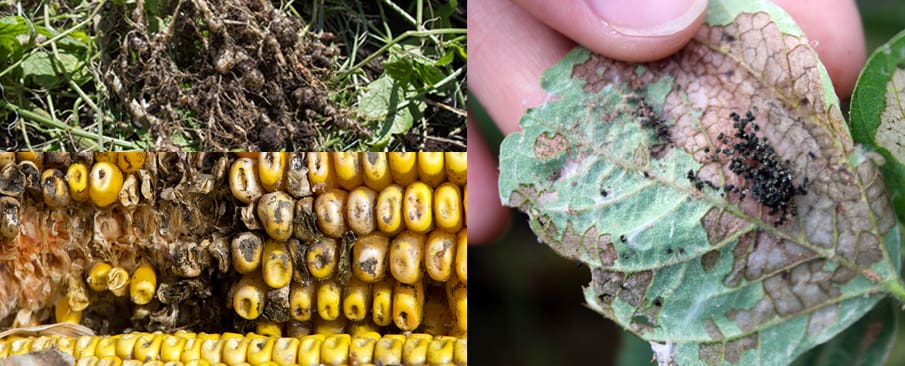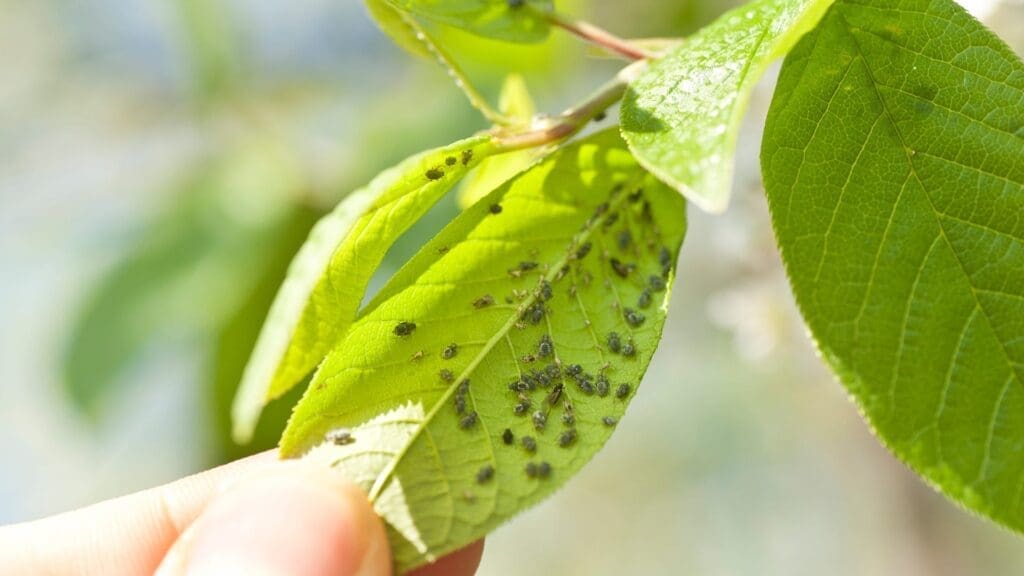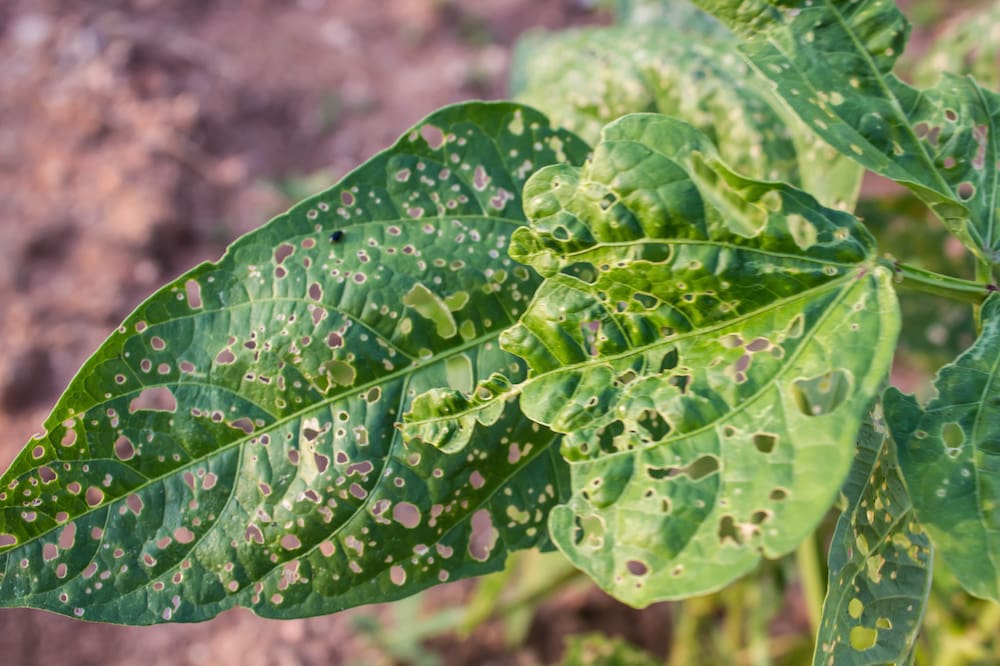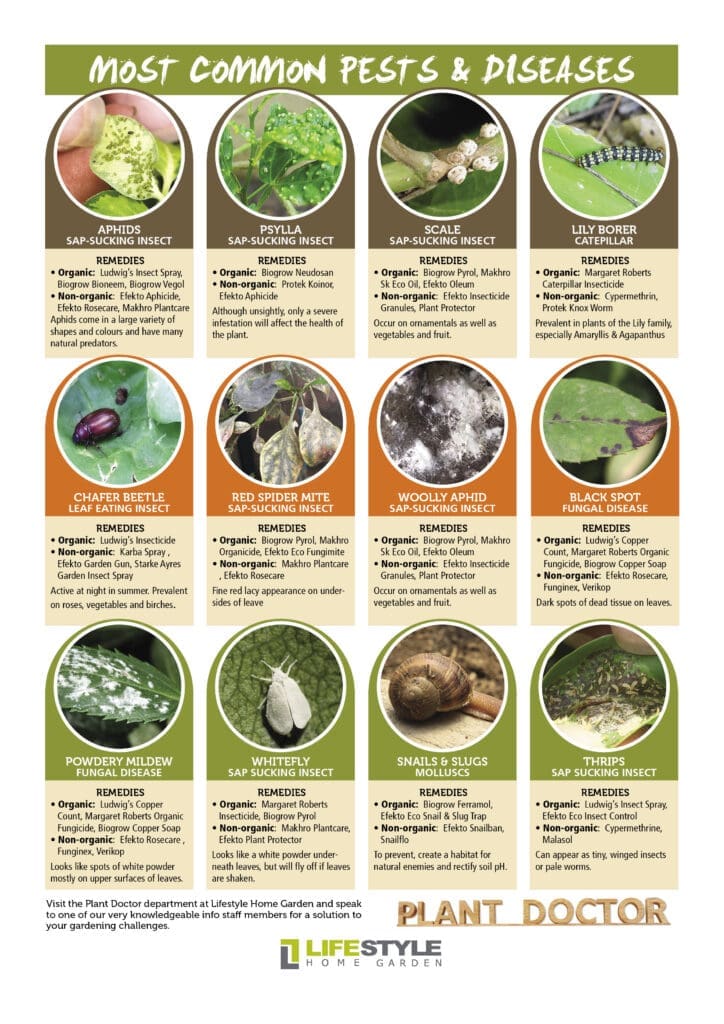Are your plants falling victim to both pests and diseases? It turns out, there’s a strong connection between the two. In this article, we’ll explore the intricate relationship between pests and plant diseases, and how they can wreak havoc on your beloved garden. By understanding this connection, you’ll gain valuable insights into how to effectively protect your plants, ensuring they stay healthy and thriving. So, let’s dig in and uncover the fascinating world of pest and disease connections in the plant kingdom!

Common pests that can cause plant diseases
Aphids
Aphids are small, soft-bodied insects that can be found on various plants. They feed on the sap of plants, sucking out nutrients and causing damage to the leaves, stems, and flowers. In addition to their direct feeding damage, aphids also have the ability to transmit plant pathogens, including viruses, from one plant to another.
Whiteflies
Whiteflies are tiny, winged insects that are commonly found on the undersides of plant leaves. Like aphids, they suck the sap from plants, causing them to weaken and become vulnerable to diseases. Whiteflies are also known to spread plant viruses, making them a major concern for gardeners and agricultural crops.
Spider mites
Spider mites are not insects, but rather arachnids. They are extremely small and can be difficult to spot with the naked eye. Spider mites feed on the sap of plants, which can lead to yellowing leaves, stunted growth, and even plant death if left untreated. These pests can also transmit plant viruses, further exacerbating the damage they cause.
Caterpillars
Caterpillars are the larvae of butterflies and moths. While some caterpillars are harmless or even beneficial to plants, others can be destructive pests. Caterpillars feed on leaves, buds, and stems, causing defoliation and weakening plants. In addition to their direct feeding damage, caterpillars can also introduce bacteria or fungi into plants through their feces, increasing the risk of disease.
Snails and slugs
Snails and slugs are mollusks that can wreak havoc on plants. They feed on a wide range of plant material, including leaves, stems, and fruits. Their feeding damage can leave plants vulnerable to diseases, as well as attract other pests that are attracted to decaying plant matter. Controlling snails and slugs is important for preventing both direct damage and the subsequent risk of disease.
Fungal gnats
Fungal gnats are small flies that are often found in indoor plants or in damp soil outdoors. The larvae of these flies feed on the roots of plants, causing damage and impacting the plant’s ability to absorb water and nutrients. This weakens the plant and makes it more susceptible to diseases caused by fungi and other pathogens.
Leafhoppers
Leafhoppers are small, wedge-shaped insects that can hop from plant to plant. They feed on plant sap, which can cause leaves to yellow, curl, or develop stippling. Additionally, leafhoppers have been found to transmit a variety of plant pathogens, including viruses and bacteria, making them a significant threat to plant health.
Thrips
Thrips are tiny, slender insects that feed by scraping the surface of cells and sucking out the contents. This feeding damage can cause leaves and stems to become distorted, discolored, or even die. Thrips can also transmit plant viruses, further compromising the health and vigor of plants.
Mealybugs
Mealybugs are small, soft-bodied insects that are covered in a waxy, white substance. They feed on plant sap and can cause damage to leaves, stems, and fruits. Mealybugs also produce honeydew, a sticky substance that can promote the growth of sooty mold and attract ants. This combination of direct damage and secondary effects can weaken plants and make them more susceptible to diseases.
Scale insects
Scale insects are small, immobile pests that attach themselves to plants and feed on their sap. They can be found on leaves, stems, and branches, often appearing as small bumps or shells. Scale insects can cause significant damage to plants, including stunted growth and dieback. Their feeding can weaken plants and make them more susceptible to diseases caused by fungi and other pathogens.
Mechanisms through which pests contribute to plant diseases
Direct feeding damage
One of the primary ways that pests contribute to plant diseases is through their direct feeding damage. Pests such as aphids, whiteflies, and caterpillars feed on plant tissues, extracting sap and nutrients. This can weaken plants and make them susceptible to infection by pathogens. Additionally, the physical damage caused by feeding can create entry points for pathogens, further increasing the risk of disease.
Vectoring plant pathogens
Certain pests have the ability to transmit plant pathogens from one plant to another, acting as vectors. Aphids, for example, can acquire plant viruses while feeding on infected plants and then transmit them to healthy plants. This vectoring ability allows pathogens to spread rapidly and cause widespread damage in agricultural and horticultural settings. Controlling pests that are known vectors of plant pathogens is crucial for disease prevention.
Creating entry points for pathogens
Pest feeding can also create entry points for plant pathogens. When pests feed on plants, they can cause wounds and physical damage, which provide an entryway for pathogens to invade. In addition, pests such as aphids and whiteflies produce salivary secretions and enzymes that can facilitate the introduction of pathogens into plant tissues. These mechanisms of pathogen entry can lead to the establishment and spread of diseases.
Inducing stress on plants
Pests can induce stress on plants through their feeding activity and physical presence. This stress can weaken the plants’ immune system and make them more susceptible to diseases. Pests may also compete with plants for resources, such as water and nutrients, exacerbating the stress and further compromising plant health. The combination of pest-induced stress and the presence of plant pathogens can have a synergistic effect, increasing the severity of diseases.

Direct feeding damage
Signs of pest feeding damage on plants
The signs of pest feeding damage can vary depending on the type of pest and the specific plant species. Common signs include chewed or distorted leaves, wilted or stunted growth, yellowing or discoloration, and the presence of holes or tunnels in plant tissues. Some pests may also leave behind distinctive feeding marks, such as webbing, trails, or droppings. Regular inspection of plants is important for early detection of feeding damage.
Effects on plant health and vitality
Pest feeding can have profound effects on the health and vitality of plants. By extracting sap and nutrients, pests weaken plants and impair their ability to carry out essential functions, such as photosynthesis and water uptake. This can result in reduced plant growth, stunted development, and decreased crop yield. In severe cases, pest feeding can lead to plant death, especially if the damage is left untreated or occurs over an extended period of time.
Weakness and vulnerability to diseases
Pest feeding damage weakens plants and makes them more susceptible to diseases caused by pathogens. The physical damage inflicted by pests can provide entry points for pathogens, facilitating their invasion and establishment in the plant tissues. In addition, the stress induced by pest feeding can compromise the plants’ immune system, lowering their resistance to diseases. This combination of weakened defenses and increased vulnerability can result in the rapid spread and severity of plant diseases.
Vectoring plant pathogens
Introduction to plant pathogens
Plant pathogens are microorganisms, including fungi, bacteria, viruses, and nematodes, that can cause diseases in plants. These pathogens can invade and colonize plant tissues, interfering with their normal functioning. Plant pathogens can be transmitted from one plant to another through various means, including infected plant material, soil, water, and vectors such as pests.
Pests as carriers of plant pathogens
Certain pests have evolved to become carriers, or vectors, of plant pathogens. These pests acquire pathogens while feeding on infected plants and then transmit them to healthy plants during subsequent feeding. This vectoring ability allows pathogens to spread rapidly and cause widespread damage. In some cases, pests may even amplify the concentration of pathogens in their bodies, increasing the likelihood of infection in plants.
Transmission of pathogens through pests
Pests can transmit plant pathogens through various mechanisms. Some pathogens can be transmitted mechanically, meaning they are physically carried on the surface of the pests’ bodies. Others may be transmitted biologically, meaning the pathogens are present within the pests and can be introduced into plants through their saliva or other secretions. Regardless of the specific mechanism, the result is the same – the introduction and spread of plant pathogens.
Examples of plant diseases spread by pests
There are numerous plant diseases that can be spread by pests. Examples include tomato yellow leaf curl virus, which is transmitted by whiteflies, and citrus tristeza virus, which is transmitted by aphids. These diseases can cause significant economic losses in agricultural and horticultural industries. By understanding the role of pests in disease transmission, proactive measures can be taken to prevent and manage these diseases effectively.

Creating entry points for pathogens
Mechanisms through which pests create entry points
Pests can create entry points for pathogens through their feeding activity and physical presence. When pests feed on plants, they can cause wounds and physical damage, which provide openings for pathogens to enter. In addition, some pests produce salivary secretions and enzymes that can facilitate the introduction of pathogens into plant tissues. These mechanisms enhance the ability of pathogens to invade and colonize plants.
Wounds and physical damage
The physical damage caused by pests can create wounds on plants, allowing pathogens to gain entry. Chewing insects, such as caterpillars, can create holes or tunnels in plant tissues, providing direct access for pathogens. Piercing-sucking pests, such as aphids and whiteflies, can cause puncture wounds as they feed, creating sites for pathogen entry. The larger the wounds and the greater the extent of physical damage, the higher the risk of disease establishment.
Salivary secretions and enzymes
Some pests produce salivary secretions and enzymes that can facilitate the introduction of pathogens into plant tissues. These secretions and enzymes can break down plant cell walls, making it easier for pathogens to enter. In some cases, pests may even inject microbial enzymes into plants, which can degrade plant tissues and provide nutrients for pathogens. The combination of salivary secretions and enzymes can significantly enhance the ability of pathogens to infect plants.
Opportunistic infection by pathogens
Pests can also indirectly contribute to plant diseases by creating favorable conditions for opportunistic pathogens. Pests can weaken plants through their feeding activity, causing stress and compromising the plants’ immune defenses. This weakened state can make plants more susceptible to infection by opportunistic pathogens, which may already be present in the environment but unable to establish themselves in healthy plants. The presence of pests can tip the balance in favor of disease development.
Inducing stress on plants
Types of stress caused by pests
Pests can induce various types of stress on plants. The most common form of stress is biotic stress, which is caused by living organisms, including pests. Biotic stress can result in direct damage to plant tissues, nutrient depletion, and reduced photosynthesis. Pests can also induce abiotic stress, which is caused by non-living factors such as temperature extremes, drought, or excessive moisture. The cumulative impact of these stresses can have a detrimental effect on plant health.
Effects on plant immune system
Pest feeding and presence can impact the plants’ immune system, compromising their ability to defend against pathogens. The stress induced by pests can trigger the production of stress hormones in plants, which can interfere with the normal functioning of the immune system. This can result in a weakened defense response and an inability to effectively recognize and combat pathogens. Furthermore, pests may also secrete compounds that suppress the plants’ immune system, further exacerbating their vulnerability to diseases.
Lowered resistance to diseases
Pest-induced stress can lower plants’ resistance to diseases, making them more susceptible to infection by pathogens. The weakened immune system and compromised defense response can provide an advantageous environment for pathogens to establish and thrive. Additionally, the physical damage caused by pests can create entry points for pathogens, further increasing the likelihood of infection. The combination of stress and increased pathogen presence can lead to the development and spread of diseases.
Interactions between pest-induced stress and plant pathogens
The interaction between pest-induced stress and plant pathogens can have a synergistic effect on disease development. The stress induced by pests can create favorable conditions for pathogens to invade and establish in plants. Conversely, the presence of pathogens can exacerbate the stress on plants and further compromise their health. This feedback loop between stress and disease can result in a rapid and severe decline in plant health if not effectively managed.

Common plant diseases caused by pests
Fungal diseases
Pests can contribute to the development and spread of fungal diseases in plants. Fungi can infect weakened or injured plant tissues, and the feeding activity of pests can create wounds and entry points for fungal pathogens. Examples of fungal diseases caused or mediated by pests include powdery mildew, downy mildew, and Botrytis blight. These diseases can affect a wide range of plant species and can cause significant damage if left unmanaged.
Bacterial diseases
Pests can also play a role in the spread of bacterial diseases in plants. Bacteria can enter plants through wounds or natural openings, and the feeding activity of pests can provide these entry points. Pests can also act as mechanical vectors, carrying bacteria on their bodies and transmitting them to healthy plants during feeding. Examples of bacterial diseases spread by pests include bacterial leaf spot, fire blight, and citrus canker.
Viral diseases
Pests are well-known vectors for many viral diseases in plants. Viruses can be acquired by pests while feeding on infected plants and then transmitted to healthy plants during subsequent feeding. This mode of transmission allows viruses to spread rapidly and cause widespread damage. Examples of viral diseases spread by pests include mosaic viruses, leaf curl viruses, and the tomato spotted wilt virus. These diseases can have devastating effects on crops and ornamental plants.
Nematode diseases
Nematodes are microscopic roundworms that can cause diseases in plants. Certain pests, such as aphids and whiteflies, can transmit nematodes from plant to plant during feeding. Nematodes can invade plant roots, causing galls, stunted growth, and nutrient deficiencies. They can also release toxins that further damage plant tissues. Nematode infestations can result in reduced crop yield and plant vigor, making them a significant concern for growers.
Fungal-like diseases
Pests can also contribute to the development and spread of fungal-like diseases in plants. Fungal-like pathogens, such as oomycetes, share similarities with fungi but belong to a different group of microorganisms. These pathogens can infect plant tissues and cause diseases such as damping-off, root rot, and late blight. The feeding damage and activity of pests can weaken plants and create conditions that promote the growth and spread of fungal-like pathogens.
Integrated pest management strategies for disease prevention
Cultural practices
Cultural practices play a critical role in preventing pest infestations and the subsequent development of plant diseases. Practices such as proper sanitation, crop rotation, and pruning and removing infected plant parts can help reduce pest populations and minimize disease risk. Maintaining healthy soil through proper nutrient management and irrigation practices can also enhance plant vigor and resilience against pests and diseases.
Biological control
Biological control involves the use of beneficial organisms to control pest populations. Predatory insects, parasitic wasps, and fungi can be introduced into the environment to target and suppress pest populations. These natural enemies can help keep pest populations in check, reducing the need for chemical pesticides and minimizing the risk of diseases. Biological control is an environmentally friendly approach to pest management and can be integrated into overall pest control strategies.
Chemical control
Chemical control involves the use of pesticides to manage pest populations. Pesticides can be effective in reducing pests and their potential to cause plant diseases. However, it is important to use pesticides judiciously and follow label instructions to ensure safe and effective application. Integrated pest management (IPM) approaches, which combine chemical controls with other management strategies, are recommended to minimize the negative impacts of pesticide use.
Physical control
Physical control methods involve the use of physical barriers, traps, or mechanical means to prevent or reduce pest damage. Examples include the use of row covers, netting, or sticky traps to exclude or capture pests. Physical control methods can be effective in preventing pest feeding damage and reducing the risk of disease transmission. However, they may not be suitable for all pests or circumstances and should be used in combination with other management strategies.
Quarantine measures
Quarantine measures involve the isolation and monitoring of plants to prevent the introduction and spread of pests and diseases. Plants should be inspected and certified as pest-free before being brought into an area. Quarantine measures can help prevent the introduction of new pests and minimize the risk of disease outbreaks. Regular monitoring and early detection of pests and diseases are essential components of effective quarantine measures.
Resistant plant varieties
Plant breeding programs have developed plant varieties that are resistant to specific pests and diseases. These resistant varieties have natural defense mechanisms that can withstand pest feeding and reduce the risk of disease development. Planting resistant varieties can be an effective strategy for reducing the impact of pests and diseases. However, it is important to rotate or diversify resistant varieties to prevent the buildup of pest populations that can overcome the resistance.
Enhancing plant health
Maintaining plant health is essential for reducing the susceptibility of plants to pests and diseases. Proper nutrition, irrigation, and soil management practices can help enhance plant vigor and resilience. Providing optimal growing conditions, such as appropriate light, temperature, and humidity levels, can also promote plant health and strengthen their natural defenses. Healthy plants are better able to withstand pest pressure and are less likely to succumb to diseases.

Preventive measures for pest and disease management
Regular inspection and monitoring
Regular inspection and monitoring of plants is essential for early detection of pests and diseases. Visual inspection of plant tissues, including leaves, stems, and roots, can help identify signs of pest feeding damage, presence of pests, or disease symptoms. Monitoring can be enhanced by the use of traps, sticky cards, or pheromone lures to capture or detect pests. Early detection allows for timely intervention and prevents the escalation of pest and disease problems.
Proper sanitation
Proper sanitation practices can help reduce pest populations and minimize the risk of disease transmission. Removing plant debris, fallen leaves, and weeds can eliminate potential hiding places and breeding sites for pests. Infected plant material should be promptly removed and disposed of properly to prevent the spread of diseases. Tools and equipment should be cleaned and disinfected between uses to prevent the transmission of pests and pathogens.
Crop rotation
Crop rotation involves the systematic change of crops in a specific area over time. Rotating crops can help break the cycle of pests and diseases by disrupting their lifecycle and reducing their buildup in the soil or on plant residues. Different plant species have varying susceptibility to pests and diseases, and rotating crops can help minimize the risk of recurrence. Crop rotation should be planned based on pest and disease histories, as well as the specific requirements of each crop.
Pruning and removing infected plant parts
Pruning and removing infected plant parts can help prevent the spread of diseases within plants and to other nearby plants. Infected leaves, stems, or fruits should be promptly pruned and disposed of properly to minimize the risk of disease transmission. Proper pruning techniques, such as making clean cuts and disinfecting pruning tools between plants, should be followed to prevent the spread of pathogens. Regular pruning can also promote plant health and vigor.
Maintaining healthy soil
Healthy soil is the foundation for healthy plants. Proper soil management practices, such as maintaining appropriate pH levels, improving drainage, and ensuring adequate organic matter content, can enhance plant health and resilience. Soil testing and nutrient management practices can help ensure plants receive the necessary nutrients for growth and defense against pests and diseases. Regular soil amendments, such as organic compost or mulch, can also promote beneficial soil microorganisms that contribute to plant health.
Using appropriate planting techniques
Using appropriate planting techniques can help minimize pests and diseases. Proper spacing between plants allows for good air circulation and reduces the risk of fungal diseases. Planting at the appropriate depth and avoiding excessive or inadequate watering can help prevent the development of root diseases. Selecting healthy, disease-free plant material and avoiding the introduction of contaminated soil or water can also help prevent pest and disease problems.
The role of pesticides in pest and disease control
Types of pesticides
Pesticides are chemical substances that are used to control pests and diseases. There are several types of pesticides, including insecticides, fungicides, herbicides, and nematicides. Insecticides target and control insect pests, while fungicides are used to prevent or eradicate fungal diseases. Herbicides are designed to control or eliminate unwanted plants (weeds), and nematicides are used to manage nematode pests. The choice of pesticide depends on the target pest or disease and the specific requirements of the situation.
Pros and cons of pesticide use
The use of pesticides can have both advantages and disadvantages in pest and disease control. Some of the benefits of pesticide use include immediate pest control, potential for high efficacy, and broad-spectrum activity. Pesticides can provide a quick response to pest outbreaks and help prevent extensive crop damage. However, there are also potential drawbacks, such as the development of pesticide resistance, non-target effects on beneficial organisms, environmental contamination, and human health concerns. Proper and responsible pesticide use is crucial for minimizing these risks.
Principles of safe and effective pesticide application
Safe and effective pesticide application requires adherence to certain principles. These principles include reading and following label instructions, using appropriate personal protective equipment, applying pesticides at the recommended rates and timings, and properly storing and disposing of pesticide containers. It is important to select pesticides that are specifically labeled for the target pest or disease and to apply them only when necessary. Integrated pest management (IPM) approaches, which integrate various management strategies including pesticides, can help minimize the need for excessive pesticide use.
Integrated pest management approach to pesticide use
Integrated pest management (IPM) is a comprehensive approach to pest and disease control that involves the integration of various management strategies, including the judicious use of pesticides. IPM emphasizes the prevention of pest problems through cultural, biological, and physical controls, and the use of pesticides is considered a last resort. When pesticides are deemed necessary, IPM encourages the use of selective and targeted products, along with proper application techniques and monitoring to minimize non-target impacts. The goal of IPM is to achieve effective pest and disease control while minimizing risks to human health and the environment.

I am Randy, the author behind PestControld.com. Drawing from decades of experience, I aim to provide valuable insights, expert advice, and practical recommendations to help you make informed decisions when assessing viable pest control solutions.